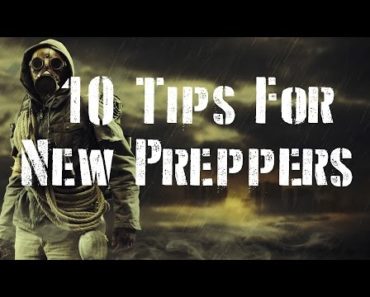Most preppers out there would love to have some free time to dedicate themselves entirely to their prepping plans or training. However, taking a few weeks off to travel to a remote forest and practice wilderness survival skills is just not possible for most folks. There isn’t enough time to do some primitive camping in these troubling times, as life keeps throwing challenge after challenge at us, with the pandemic, economic situation, and so on.
Fortunately, most of the survival skills needed to survive a worst-case scenario can be practiced right in your backyard. You will save money by avoiding traveling to a remote, privately owned forest, and if things don’t go your way, help will always be in reach. Let’s look at how you can improve yourself without leaving behind the “comfort” of your backyard.
Fire making
The ability to start a fire under any conditions is an invaluable skill to master. It’s better to practice various fire-making techniques without the added stress of an unknown environment or time-challenging requirements like signaling for help or the need to warm yourself after being submerged in cold water.
Even if there may be some city restriction on what can be burned and when the firepit in your backyard can prove the right place to practice your fire setup and fire-starting skills.
You can use various fire-starting tools, like a ferrocerium rod, a strike-anywhere match, or perhaps the bow drill.
How about using a magnifying glass to start a fire?
Not only will you figure out how troublesome it will be to start a fire using it, but you will also learn how much time it takes to ignite your tinder.
Gather tinder and use your stone brick fire pit or metal bowl to experiment with various natural materials. You can use tree bark, bird nests, and everything you may find lying around, including rags and trash because chances are you may find most of these materials out in the wild.
How about experimenting with different fire lays? How about trying the Dakota fire hole or the Swedish torch?
Most folks are familiar with the teepee fire lay, and it seems that everyone builds it instinctively without overthinking it. However, there are various other fire lays that can be used depending on your needs, and only by taking the time to build them will you discover the challenges each fire lay brings.
Make things harder for yourself since it won’t all go your way in a real-life survival scenario. How about immobilizing one arm and trying to start a fire using only the “healthy” arm?
You can also try to ignite wet tinder or perhaps try to use a Ferro rod at night and figure out how the sparks will affect your night vision. There are so many options to make your life harder, and honestly, you are only limited by your imagination when trying to make things more challenging for yourself.
Off-grid cooking
And since you started a fire in your backyard, how about doing some cooking and putting said fire to good use?
Cooking over open flames is an art, and a lost skill, in my opinion, since the outdoors setup is never the same and the elements can work in your favor or against you.
Most people think about impaling something (usually an animal or part of an animal) on a stick and holding it over open flames until it cooks, and that’s pretty much all there is about traditional campfire cooking. However, things are not that simple, and here are some things you should be aware of.
First of all, you don’t cook over open flames unless you’re in a hurry and time works against you. You want to cook your meal over the coals since they can provide a more stable temperature, and you won’t risk burning your food. And second, a constant temperature will allow for even cooking, and you won’t risk having the outside of your food burnt and the inside cold or raw.
Another thing you can do in your backyard safely is experiment with various types of cookware and foods without the risk of going hungry if you screw things up. You bought a Dutch oven or a deep skillet, and you plan on bringing them along if you bug out and head for the woods. Now, in times of peace, you have the perfect opportunity to test your gear and cooking abilities.
Not to mention that you may discover that some of the gear you brought is nothing more than false advertising and may be rendered useless when exposed to the high heat generated by a campfire. I’ve had camping companions bragging about their new cookware for hours, and when the time came to cook a decent meal, their cookware bent, and the plastic handles melted.
Animal tracking
Learning to identify animals by their tracks is a great way to determine what animals live in your area and what visitors you have at night. Even more, some of these animals may become a food source should the need arise.
You may discover that those tracks leading to and away from your tumbled garbage cans are from a raccoon, or perhaps they’re not from your neighbor’s dog, and a coyote has found its way into the neighborhood.
You can get outside your backyard, especially during the winter season, since snow makes animal tracking easier. Don’t hug the fireplace like your neighbors and venture outside to see who’s been visiting your yard and what new neighbors have moved in. Once you learn to identify the prints, you can move to the next step and practice following those tracks as far as you can.
And besides being a valuable skill, animal tracking is also an excellent opportunity to teach your kids about nature and bond with them. It’s a pleasant activity that gets them out of the house, and they won’t stay glued to their smartphones all day.
Identifying wild edibles
How about the wild edibles that grow in and around your backyard?
You may be a die-hard meat eater, but a meal is not complete without some greens and the salts and minerals they provide. In the wilderness, being hungry will make you want to eat anything that looks remotely edible.
Before you try your luck with wild foods in the great outdoors, how about you start recognizing wild edibles in your backyard and its vicinity? Go to the local library and get a field guide and figure out which of the weeds growing in your yard may end up on your plate.
Once you identify the edible plants in your area, you can learn how to use those plants and if it’s worth transplanting and growing them. And the goal here is not to become a botanist overnight but rather be able to identify a shortlist of plants that can be used to stop your belly from growling if need be.
And when it comes to wild edibles education, people forget that having a field guide is just the first step, and a lot of time and dedication is needed to identify a plant correctly.
First of all, most field guides will show you how the plant looks when it’s ready to be harvested, and that may not always work in your favor. You need to be able to identify plants at various stages of their growth to map your area early in the season, before the harvesting time.
Second, many plants have similar characteristics since they are part of the same plant family, but not all species are edible or safe to handle. You will need to learn to tell plants apart now when a mistake can be managed without dire consequences.
And lastly, just because a plant is edible, it doesn’t mean that your belly will be happy with it. You may not like its taste, you may have trouble eating more than a handful, or perhaps your digestive system won’t agree with you. Each person’s body is different, and just because someone can eat wild edibles without “repercussions” doesn’t mean you can do the same.
Try various edibles now when it’s safe to do so because you will learn which of those you can hold down and if you can depend on those plants if you find yourself stranded in the wilderness.
Staying in shape
Many preppers ignore physical fitness, and exercising is not as “fun” as trying other survival skills. However, the poor physical condition may be a killer in a survival situation, and there will be a lot of activities that will test your body and its endurance.
Now, I’m not saying you have to start lifting weights or becoming a fitness expert, but if you can’t walk from your front door to the upstairs bedroom without getting winded, that might be a problem.
You have to get that blood pumping and work your heart rate up a bit if you want to make sure you can head for the woods and make it there when the proverbial brown stuff hits the fan.
Before you start to plan your fitness program and work on your exercise routine, start by getting a checkup to figure out if there’s an underlying health issue that may foil your plans. If you get an “ok” for your physician, you can plan your training program however you seem fit. However, if there is a health issue you should keep an eye on, your exercising routine must be adapted accordingly.
And to stay in shape, you don’t need to invest in a ton of workout gear or fancy exercising equipment. Even playing a game of tag with your kids will get that heart rate up, or perhaps you want to try your skills at shooting hoops.
Once you start to move your butt, regardless of whether you start jumping rope or playing with your kids more outside (and for longer), you will notice some health improvements.
If you feel confident about yourself, you can even try self-defense training and ask your spouse or significant other to be your training partner. You will both learn some valuable skills that someday may be put to the test.
Other activities
There are all sorts of activities you can try in your backyard, and it all depends on what skills you want to practice and improve. You may not be able to fire your guns in your backyard, but you may shoot a crossbow or try your luck with a slingshot.
You can also improvise various shelters with what you have in your backpack or set up your tent and learn to speed things up. You can use a tarp and try different shelter designs or use it to collect water and see what works and how much water you can obtain after a short rain burst.
How about setting some traps or practicing with your snares? Maybe that raccoon won’t go through your trash anymore if you’re successful. Or perhaps you want to rig a Paiute deadfall trap and get rid of some mice.
Concluding
The safety of your backyard and its vicinity provides the perfect place to test and improve some of your survival skills. No matter what you are going through right now or what your living situation might be, you should always be able to find some time to test your survival skills. Of course, practicing and improving some of your skills may require specific creativity on your side, but after all, a true survivor never gives up.




























